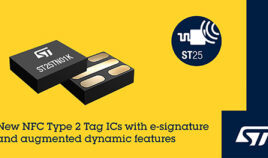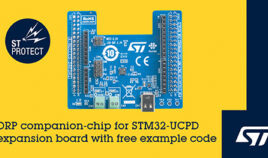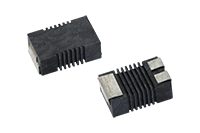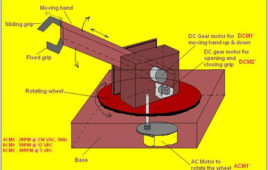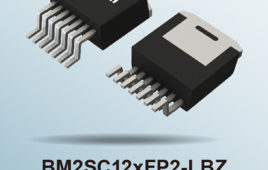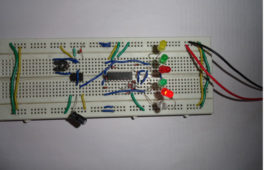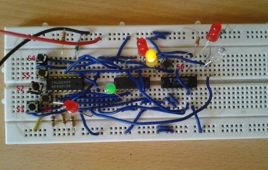Renesas Electronics Corporation, a supplier of advanced semiconductor solutions, has introduced a new family of multi-cell full battery front-end (BFE) ICs for battery management systems (BMS). They are built for the larger, high-voltage battery packs that power e-scooters, energy storage, high-voltage power tools, and other high-voltage equipment. The new ICs provide fast, flexible, cell balancing…
Renesas expands its 5G mmWave beamformer portfolio
Renesas Electronics Corporation, a supplier of advanced semiconductor solutions, has expanded its 5G beamformer IC family with two dual-polarization mmWave devices, optimized for 2×2 antenna architecture for 5G and broadband wireless applications — with best-in-class performance at n257, n258, and 261 bands. The highly integrated F5288 and F5268 transmitter/receiver (8T8R) chipsets sit on a small…
STMicroelectronics launches NFC Type 2 Tag IC with privacy features
STMicroelectronics’ ST25TN512 and ST25TN01K NFC Forum Type 2 tag ICs deliver a new balance of cost and performance for high-volume use cases like consumer engagement, product information, and brand protection. Also suitable for smart-city applications and access control, the ST25TN512/01K NFC tag ICs support multiple user-protection and privacy mechanisms including a seven-byte unique chip-identifier code, TruST25 digital signature, NFC…
STMicroelectronics offers port-protection IC for STM32 MCUs with USB-C dual-role power
STMicroelectronics‘ TCPP03-M20 USB Type-C port-protection IC is tailored for dual-role power (DRP) applications, simplifying the design of products that can act as a power source for connected devices, as well as accepting power from other USB-C sources. When used as a companion chip with STM32G0*, STM32G4, STM32L5, and STM32U5 microcontrollers that contain ST’s UCPD (USB…
Vishay’s new high-voltage chip divider improves TC tracking performance
Vishay Intertechnology has introduced the industry’s first high-voltage chip divider to be offered in a ribbed, molded package with compliant surface-mount leads. Designed to reduce component counts and improve TC tracking performance and ratio stability in automotive and industrial equipment, the Vishay Techno CDMM delivers a maximum working voltage of 1500 V in the 4527 case…
Microchip launches high-precision, voltage-reference ICs for automotive applications
Extended-temperature-range voltage reference ICs for automotive and industrial applications require low drift along with high reliability and performance. To this end, Microchip Technology announced the release of a high-precision voltage reference (Vref) IC that meets these needs at a cost-effective price. The new MCP1502 is an AEC-Q100 Grade 1 (-40° to +125° C operating temperature…
Computerized Pick n Place Robot
Complete robot is combination of three subsections: Robotic mechanism, Hardware driver circuit, controlling software in VC++.Obviously, the main part will be the mechanism that actually forms the body of robot means moving hand that picks or places any object. Function of hardware driver circuit is to drive all three motors and actuates all the motions of robot. Controlling software is also an important part of this robot because it will take care of all controlling actions. The main functions of this section are: Rotate the hand to one specific angle from where the object should be picked or to be placed, Move the hand up or down to pick or place the object, and Open or close the grip of hand depending upon size of object.
Analog Devices offers tiny power-management IC for wearables
The new MAX77659 single-inductor multiple output (SIMO) power-management IC (PMIC) with integrated switch-mode buck-boost charger from Analog Devices. charges wearables, hearables, and Internet of Things (IoT) devices faster and in less space than any other PMIC available today. The MAX77659 SIMO PMIC delivers over four hours of play time after a short, 10-minute charge, and…
CD4001 IC -based Lighting System
CD 4001 is a quad, 2 input NOR gate IC made by Fairchild Semiconductors. It is a monolithic CMOS transistor based IC having efficient source and sink [[wysiwyg_imageupload::]]capabilities. Circuits that use this IC can be easily operated using battery as CD4001 is a low power consumption IC. A 14 pin DIP package, this IC can work at temperatures upto 1250. The circuit in this project is built around a commonly used CD4001 IC and few more discrete components. The circuit described can be used to decorate your Christmas tree with colorful lights. The blinking of LED’s will create a festive appearance which will enhance the Christmas mood.
STMicroelectronics partners with Paco Rabanne to advance contactless technology
STMicroelectronics, a global semiconductor provider, announced its collaboration with Paco Rabanne on the European fashion house’s new Phantom fragrance for men. Phantom is packaged in a unique connected bottle that uses an embedded near-field communication (NFC) tag IC, using a popular contactless technology supported by most smartphones to connect to its online, “Phantom Universe.” Access to Paco…
Renesas launches radiation-hardened plastic portfolio for satellites
Renesas Electronics Corporation, a supplier of advanced semiconductor solutions, has launched a new line of plastic-packaged radiation-hardened (rad-hard) devices for satellite, power-management systems. The four new devices include: ISL71001SLHM/SEHM point-of-load (POL) buck regulator ISL71610SLHM digital isolator ISL71710SLHM digital isolators ISL73033SLHM 100V GaN FET and integrated low-side driver By combining rad-hard assurance levels with the board…
ROHM’s industry-first AC/DC converter ICs offer built-in 1700V SiC MOSFET
ROHM is introducing a new, AC/DC converter ICs with a built-in 1700V SiC MOSFET, BM2SC12xFP2-LBZ in the TO 263-7L package. It’s optimized for industrial applications, focusing on auxiliary power supplies for street lamps, commercial air-conditioning systems, general-purpose inverters, and AC servos drives. An auxiliary power supply is an essential and vital part of industrial applications…
Maxim expands its expands its MAXSafe Technology monitoring line
Maxim Integrated Products, Inc. has expanded the MAXSafe Technology line with the MAX22530, an isolated, field-side self-powered 12-bit system monitor. Featuring four channels, the MAX22530 provides isolated system monitoring to improve accuracy 50x and to reduce solution size by 40 percent by integrating five components into a single IC. Automation system designers continually seek ways…
Generating time delay using astable mode of 555 timer IC
This circuit based project demonstrates the working of 555 timer in astable mode to generate pulses of time period 0.5 second. This pulse can be further used [[wysiwyg_imageupload::]]for anything where we need a pulse such as to blink a LED or to create fashionable blinking lights. This circuit of this project makes the use of timer IC NE555 which produces a constant square pulse of a desired frequency. This pulse could be either triggered or could be produced continuously depending upon the mode of 555 we are using. The two mostly used modes of 555 are Monostable and Astable. Here it is used in the astable mode with time period of half second, with high time period of 0.333 seconds and low time period of 0.166 seconds. Keep on reading to find out how the circuit is constructed and in what mode does the 555 IC works.
Light dependent frequency variation using LDR
This circuit responds to the change in light illumination in the form of varying frequency which can be observed through a flashing LED as output. The idea of [[wysiwyg_imageupload::]]this project is to use an LDR in place of a fixed value resistor which in turn generates a particular frequency. The generated frequency corresponds to the light conditions of the ambience.This concept finds popular application in motor speed control where the output is connected to motor driver circuit. Disco light is another interesting application of the idea where the lighting pattern keeps on changing. The circuit of this project uses NE555 to generate a continuous series of pulses in astable mode. The frequency of these pulses is obtained based on values of two resistors and a capacitor. Keep on reading to find out more information on the circuit and its working.
Negative supply using 555 IC
This circuit and project demonstrates the application of 555 to generate negative supply. The negative supply produced is about 3 volts lesser than the applied [[wysiwyg_imageupload::]]voltage due to various losses. At times the circuit requires both negative and positive supply, which is not available in the batteries. IC555 includes two comparators, one RS flip-flop and other few discrete components like transistors, resistors etc. The biasing voltage (Vcc) is divided in three parts through voltage divider using same value of resistors R. from these 1/3 Vcc is given to non inverting terminal of trigger comparator and 2/3 Vcc is given to inverting terminal of threshold comparator. The outputs of both comparators are given to R and S inputs of flip-flop. The Q’ output is actual output of IC and Q output drives. In this project, 555 work in astable mode and produces a frequency of about 663 hertz.
Seismic sensor using opam and piezo sensor
The project on Seismic sensor circuit described here senses pressure variation or mechanical strain and responds by sounding a speaker. It can be used at [[wysiwyg_imageupload::]]prohibited places to alert any unwanted entry. Such sensors can be placed on the floors of these places and whenever an intrusion would occur, the speaker would go off. The term “Seismic” is used majorly for all the operations and processes related to the earth, its crust and lower layers. The similar areas are there where this sensor finds its applications: 1. Decoding natural vibrations under the earth’s crust through seismograph 2. Aid in large industrial processes of oil extraction drilling process, mining, tunnel construction etc.
Light sensor using photodiode and opam
The project about light sensor circuit shows the application of photodiode to detect the presence of light. This light sensor can be used as an intermediate circuit [[wysiwyg_imageupload::]]in various applications to detect the presence or absence of light. The sensitivity of the sensor can be adjusted using the preset. This circuit is based around a LM339 comparator along with variable capacitors, photodiode, LED and a solo resistor. A photodiode, used as a photo detector, generates current in the circuit when light incidents on it. The circuit of this project uses the photodiode in reverse bias mode with resistor R1. The LED at the output will glow when light falls on the diode. In such a condition, the inverting input drops to a lower value than the reference set at the non-inverting input and so the output goes providing the necessary forwards bias to the LED.
Dancing LED’s
The circuit is used for decoration purpose or as an indicator. Flashing or dancing speed of LED’s can be varied with the help of variable resistor and various dancing pattern of light can be formed by slight change in the circuit. In this circuit 6 LED’s moves in one direction then again flow the opposite direction than previous. The circuit is based on two IC’s namely NE555 and CD4017 with few more components. 555 timer IC wired as an astable oscillator. In this circuit NE555 astable generates a clock for the circuit which provide a oscillating wave to the output pin 3 of IC1. You can vary the speed of oscillation with the help of VR1. The frequency of oscillation of 555 timer can be calculated by f=1.44/(R1+2*(VR1)*C1) and CD4017 is a CMOS counter/ divider IC. It take clock signal from the clock input and turn on the 10 output in sequence, each time when it receives clock input pulses. It is the most popular IC and extremely useful in various project like Light Chaser, Matrix Die. In order to understand the working of IC one must know about its individual pin.
Implemetation of BODMAS Rule using IC’s
Everyone has studied this rule in their childhood. It stands for “bracket, “off”, “division”, “multiplication”, “addition”, “subtraction”. A mathematical operation involve a number of operators but they must carry out in a particular order. The circuit described here will help you to practically implement the BODMAS rule which we have studied.The circuit is made with the help of three IC’s namely 7404, 7408 and 4073. 7404 is a hex inverter or NOT gate IC. It is a 14 pin IC and contain 6 individual NOT gate on a single IC. 7408 is a quad 2 input AND gate IC. It contains 4 individual AND gate on a single IC. 4073 is a triple 3 input AND gate. It contains 3 individual AND gate on a single IC. LED, switches and resistors are also used in this circuit.



